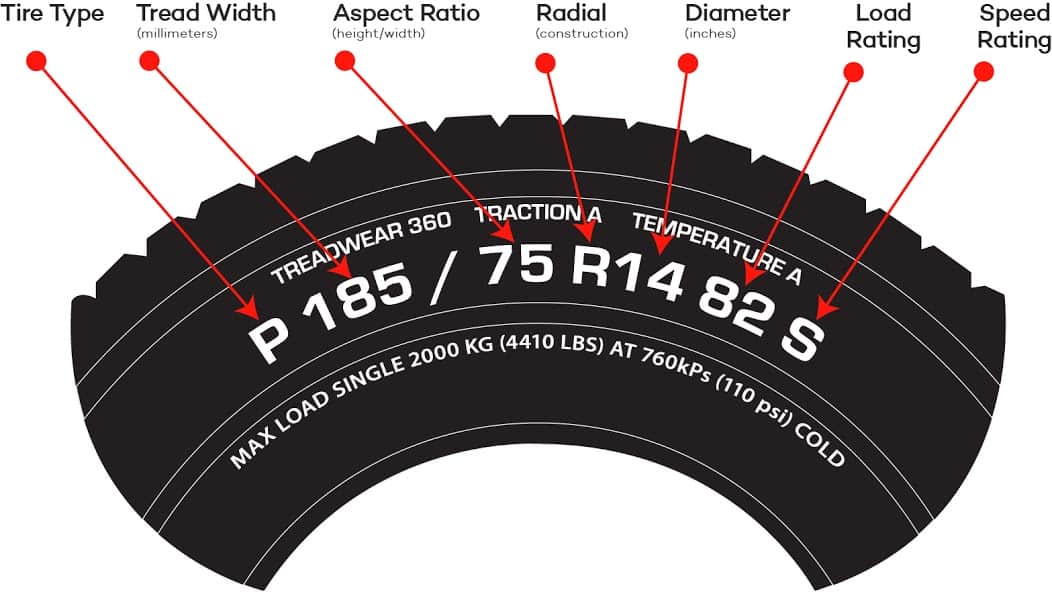The numbers on your tires contain important information about their size and performance. Understanding these numbers helps you choose the right tires for your vehicle. In this article, we’ll break down what each number means and why it matters for your driving safety and comfort.
Tire Numbers Explained
The numbers on your tires show important details about their size, type, and performance. Here’s a simple breakdown of what they mean.

Tire Type
The first letter in a tire’s code identifies the type of vehicle the tire is designed for. Here’s a break down of what these letters mean:
- P: Stands for “Passenger” and indicates the tire is intended for standard cars and SUVs.
- LT: Stands for “Light Truck” and is used for tires designed for trucks, SUVs, and vans that carry heavier loads.
- T: Stands for “Temporary” and signifies a spare tire, which is meant for short-term use.
- C: Stands for “Commercial” and indicates the tire is designed for commercial vehicles like delivery vans.
This letter helps you choose the right type of tire based on your vehicle’s needs.
Tire Width
The tread width, shown as the first number in the tire size code, tells you the tire’s width in millimeters. This width affects how the tire grips the road, influencing handling, stability, and traction.
Wider tires offer better grip and stability but may reduce fuel efficiency and increase road noise. Narrower tires can improve fuel efficiency and maneuverability but might provide less traction.
Tire Aspect Ratio
The aspect ratio number in a tire size code shows the sidewall height as a percentage of the tire’s width. A higher aspect ratio means a taller sidewall, which can make for a smoother and more comfortable ride. A lower aspect ratio means a shorter sidewall, which can improve handling and cornering but may lead to a firmer ride.
Tire Construction
The construction type in a tire size code is shown by a letter, like R for Radial or D for Diagonal. This letter indicates how the tire’s layers are arranged:
- Radial (R): The layers run perpendicularly from the center, improving handling, stability, and fuel efficiency.
- Diagonal (D): The layers run diagonally, which can make the ride more comfortable but may reduce handling and fuel efficiency.
The construction type affects how the tire performs and feels while driving.
Wheel Diameter
The wheel diameter in a tire indicates the size of the wheel rim that the tire fits, measured in inches. The wheel diameter in a tire indicates the size of the wheel rim that the tire fits, measured in inches.
Load Rating
The load rating shows the maximum weight a tire can safely carry when properly inflated. It’s a number on the tire size code or sidewall, ranging from 0 to 150. Picking the right load rating ensures your tires can support your vehicle’s weight and any extra load.
Speed Rating
The speed rating on a tire shows the highest speed the tire can safely handle when properly inflated. It’s represented by a letter, each corresponding to a specific speed limit. Picking the right speed rating ensures the tire performs safely at your driving speeds.
Here are common speed ratings and their corresponding maximum speeds:
- Q: Up to 99 mph (160 km/h)
- R: Up to 106 mph (170 km/h)
- S: Up to 112 mph (180 km/h)
- T: Up to 118 mph (190 km/h)
- U: Up to 124 mph (200 km/h)
- H: Up to 130 mph (210 km/h)
- V: Up to 149 mph (240 km/h)
- W: Up to 168 mph (270 km/h)
- Y: Up to 186 mph (300 km/h)
- Z: Over 149 mph (240 km/h, often used with higher-performance tires)
Summary
Knowing what the numbers on your tires mean helps you make better choices for your vehicle. It ensures you get the right size, type, and performance for your driving needs. By understanding these details, you can maintain safety, improve handling, and enhance your driving experience. Always check these numbers to keep your vehicle running smoothly.
